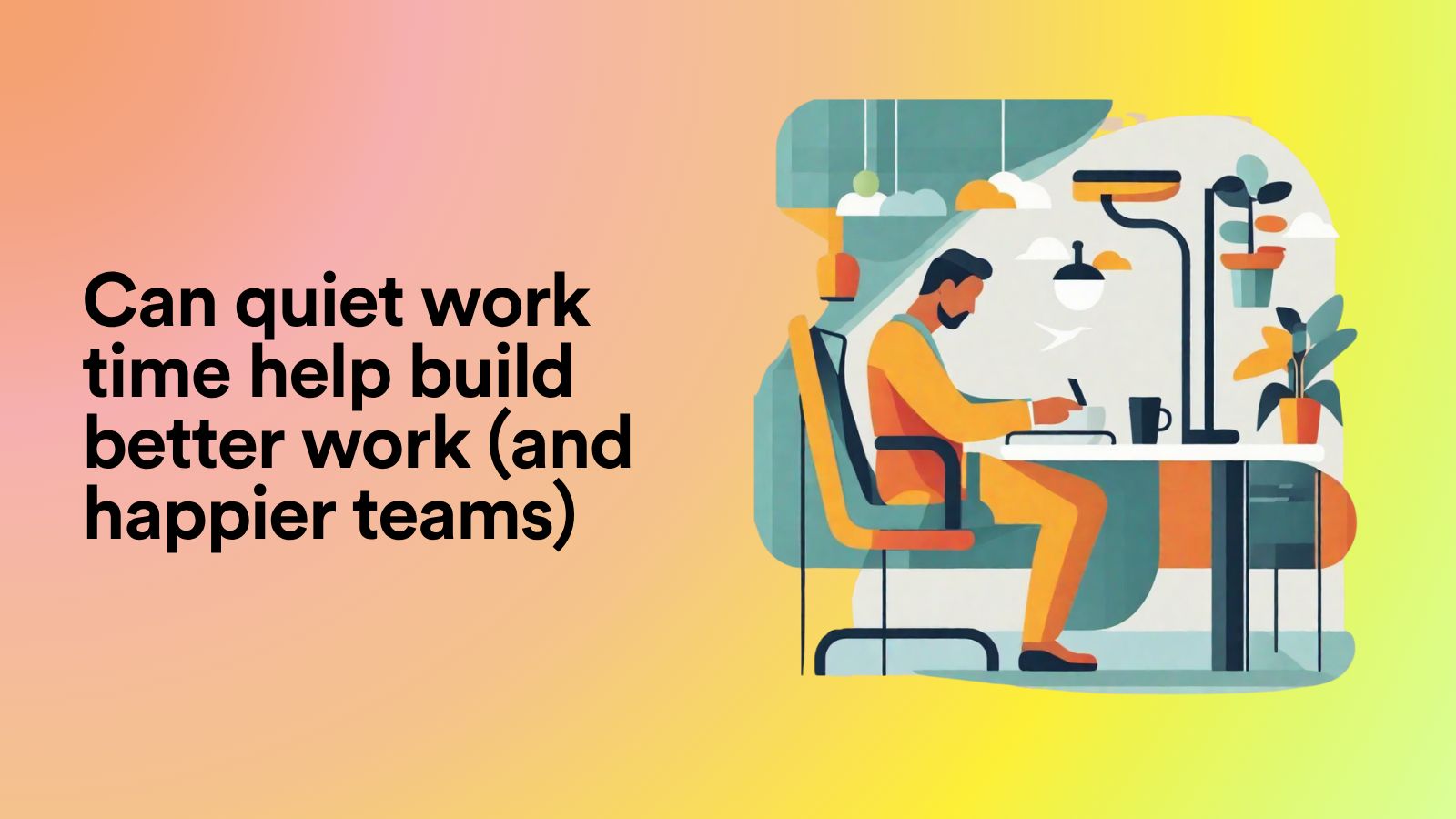Can Quiet Work Time Help Build Better Work (and Happier Teams)?

Incessant shoulder taps, impromptu hallway huddles, and kitchenette collabs, not to mention cross-cubicle communication (AKA arbitrary shouting). In short, workplaces can be incredibly noisy, distracting, and ultimately counterproductive.
Having worked in a newsroom, trying to research, write, and edit articles within a deadline, I would have done ANYTHING to get an hour of quiet time and some actual work done. However, since working from home, there is still a barrage of distractions in the form of:
- Bings
- Pings
- Rings
- Zooms
- Seemingly constant calendar chimes

Introducing quiet hours at work could be your savior in terms of productivity, but how can you best bring them into your workflow? Moreover, how do you introduce them across teams and get buy-in from the beginning? Read on to learn the answers to these burning questions and more!
Key takeaways
- When used collaboratively, quiet time helps normalize focus and lessen the pressure to be responsive all the time.
- By reducing digital noise (unnecessary meetings, messages, and alerts), it increases productivity by making room for in-depth work.
- It supports a variety of working styles. Quiet time is ultimately an inclusive practice as introverts, neurodiverse workers, and knowledge workers all flourish in low-friction environments.
- It’s easier to implement than you think. Teams can implement quiet time without changing workflows by using calendar blocks, status updates, no-meeting windows, and quiet zones.
- Long-term integration of quiet time into team culture can be achieved through creating rules, experimenting, and acknowledging its benefits.
What is a quiet time at work?
When I first heard the phrase “quiet time at work,” I pictured tired office workers grabbing blankets and heading to the beanbags for a nap like daycare kids.
But no, there are no binkies, lullabies, or actual naps involved.
Instead, quiet time is a dedicated part of the workday when everyone focuses without interruptions. During this period, non-essential communication like emails, messages, and meetings is kept to a minimum.
The idea is simple: by setting a shared expectation of silence and focus, teams can get more done in less time. It helps to:
- Reduce distractions
- Improve productivity
- Support deep work
You, as an individual, or your entire team, can schedule quiet time in various ways. It's particularly helpful in remote and hybrid settings where digital alerts have yet more potential to divert focus, given the only person watching over you is, well, you.
Quiet time benefits
Implemented correctly, quiet time can improve focus, creativity, and general well-being at work in various ways:
- By safeguarding your and your team’s mental capacity
- Allowing workers to focus on their work without constant context switching
- Reducing notification fatigue and digital noise
- Making room for problem-solving and strategic thinking
- Assisting introverted and neurodiverse team members *waves* who typically thrive in low-stimulation settings
When accepted as a whole, quiet hours show respect – not just for deep work but for people's respective boundaries and unique limitations (which make us human). It’s an acknowledgement that not everyone thrives in the same environment. It also creates space for everyone to breathe, think, innovate, and contribute without constant disruption.
Quiet work time examples
Typically indicated by calendar blocks or (non-intrusive) status updates, quiet time should be a team-wide strategy that limits interruptions (bings, pings, zooms, repeat) to support that all-important deep focus.
Depending on the structure of the team, the workplace, and the communication standards, quiet work time can take many different forms. Making time for unbroken concentration is the constant objective. Below are practical examples that show how teams implement it across different settings.

- No-meeting blocks: To allow for in-depth work, teams set aside particular times or days (such as Wednesday afternoons) when meetings are not allowed.
- Notification-free windows: To cut down on digital noise, staff members turn off email, Teams, and Slack notifications during designated times.
- Calendar-protected focus time: Individuals block out time on their calendars labeled “Focus” or “Quiet Work” to signal availability boundaries.
- Zoning in open offices: Physical spaces are marked for silent work, often with signage or sound-dampening features (you don’t need to build sound-proof booths, headphones will suffice).
- Teamwide quiet hours: Everyone agrees on a set time slot (e.g., daily 9–11 AM) during which communication is suspended unless absolutely necessary.
Hopefully, these examples drive home that introducing quiet time – while a structural decision – can be pretty straightforward to implement so that teams can make choices that promote better work, not just ones based on personal preference.
Introducing quiet time
Introducing quiet time, whether in-person or remotely, helps normalize concentration and lessen the pressure to be responsive all the time. It's a relatively minor change that has a huge effect on well-being and productivity. However, saying that is one thing; getting actual team buy-in from the outset is another.
In order to build genuine sustainable support, quiet time must be framed as a shared productivity asset rather than either a limitation or some form of enforcement. When teams view it as a tool that preserves their time rather than restricts their independence, they're more likely to adopt it.
Needless to say, leaders are essential in establishing expectations early on and modeling appropriate behavior. Here are some practical ways to introduce quiet time without pushback:
- Begin with a pilot: Before making it official, test a two-week quiet time window and take team feedback.
- Co-create the rules: Let the group determine the best time and methodology for quiet time.
- Implement calendar signals: No, not another ping, rather a visual cue. To make quiet time a part of the team rhythm, encourage everyone to clearly block it out using color coding. It could even be a case of a basic traffic light system. In other words, if Ryan is time blocked as red from 11am - 12pm, leave him be.
- Make exceptions clear: Specify what is considered “urgent” and how to contact someone in a quiet moment if necessary.
- Acknowledge those wins: To reaffirm its importance of the practice, be sure to share examples of improved focus or reduced stress to reinforce its value.
The most effective quiet time is one that is inclusive, flexible, and well-communicated. Instead of being a top-down directive, it becomes a cultural shift when it’s anchored in team goals, such as increased output or fewer signs of burnout. The more the team shapes it, the more likely it is to stick.
Wrapping up
So, hopefully you’re clearer on the concept of quiet time; it’s not just a personal habit but a team productivity practice. As for how Memtime can help here? Let us count the ways!
- Automatic time tracking: Memtime passively records your work habits, assisting you in determining when you are most naturally focused and when distractions start to appear.
- Visual time blocks: With data-backed scheduling, it's easier to safeguard quiet time by displaying how your day is spent.
- Zero manual input: Memtime facilitates quiet time without making additional noise because it operates in the background.

Tools that promote focus without creating additional friction are the most effective way to support quiet time. Memtime does just that by enabling introverts, knowledge workers, and teams alike to protect their most productive hours by bringing visibility to the workday.
It can help transform good intentions into enduring habits, whether you're attempting to schedule quiet hours for a team or carve out deep work time for yourself.
To see how it can shine a light on your working week, give our 14-day free trial a try today. There's literally nothing stopping you:
What’s the difference between quiet time and deep work?
Quiet time is a window set aside by the team to reduce distractions like meetings and conversations. This concentrated, highly cognitive effort that takes place during that period is known as "deep work." Deep work is the product of quiet time.
How long should quiet time last?
Although there isn't a one-size-fits-all solution, most teams begin with blocks of one to two hours. Daily morning sessions (e.g., 9 - 11 AM) are preferred by some, while afternoon meetings are avoided by others. The key is consistency and team alignment.
Can quiet time work in open-plan offices?
Yes, groups can use noise-canceling headphones, sound-dampening equipment, or signage to mark off quiet areas. Color-coded calendar blocks and desk flags are examples of visual cues that help indicate when someone shouldn't be disturbed.
How do remote teams manage quiet time?
To preserve quiet times, remote teams frequently use shared calendars, status updates, or "do not disturb" settings. Additionally, some people support notification-free windows that only permit urgent messages.
Is quiet time just for introverts?
Not at all. Reducing distractions benefits everyone, but introverts and neurodiverse people may benefit the most. All working styles benefit from quiet time because it promotes clearer thinking, fewer mistakes, and more significant results.
How does quiet time reduce burnout?
By allowing workers to take a break from continuous notifications and reactive tasks, quiet time helps avoid burnout. It reduces cognitive overload, respects personal boundaries, and makes room for undivided focus – especially for people who feel exhausted from constantly being "on." This eventually results in a healthier work rhythm and improved energy management.
What tools help enforce quiet time?
Without micromanaging, tools like focus timers, calendar integrations, Slack status updates, and Memtime support quiet time. Additionally, passive time tracking can show when interruptions increase.
Sheena McGinley
Sheena McGinley is a columnist and features writer for the Irish press since 2008. She’s also a business owner that is conscious of how time tracking can foster progress. She wrote for SaaS companies and businesses that specialize in revenue optimization by implementing processes. She has the unique ability to digest complex topics and make them easy to understand. She shares this precious skill with Memtime readers. When she's not making words work for people, Sheena can be found taking (very) brisk dips in the Irish Sea.






